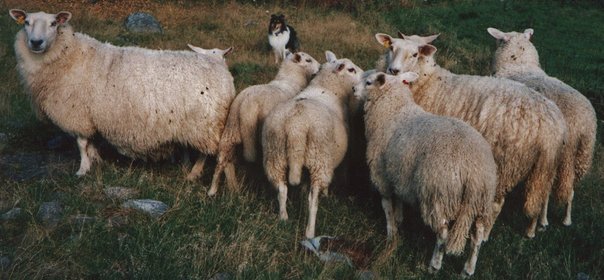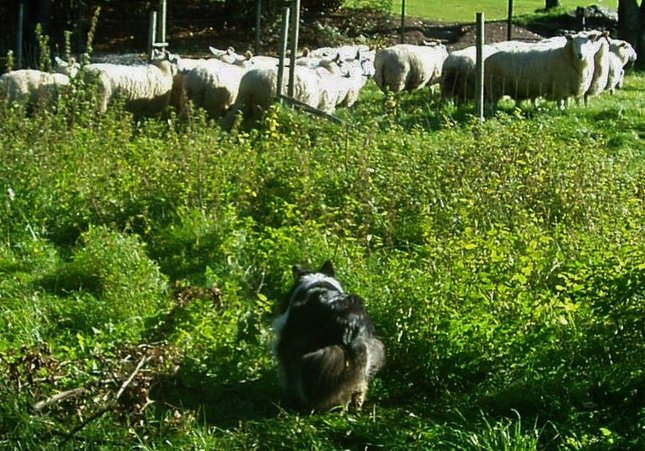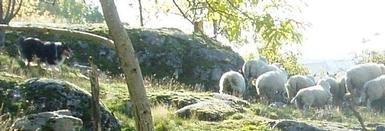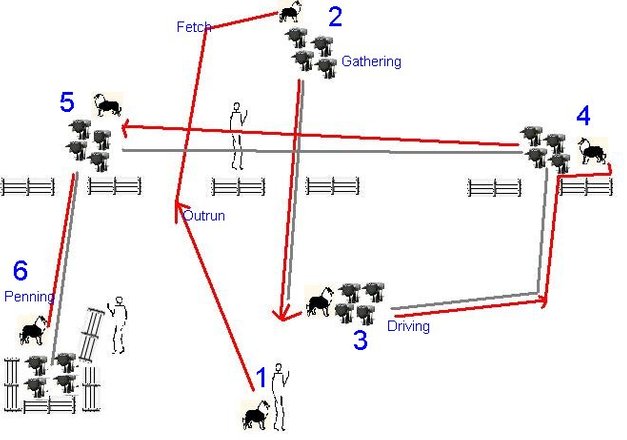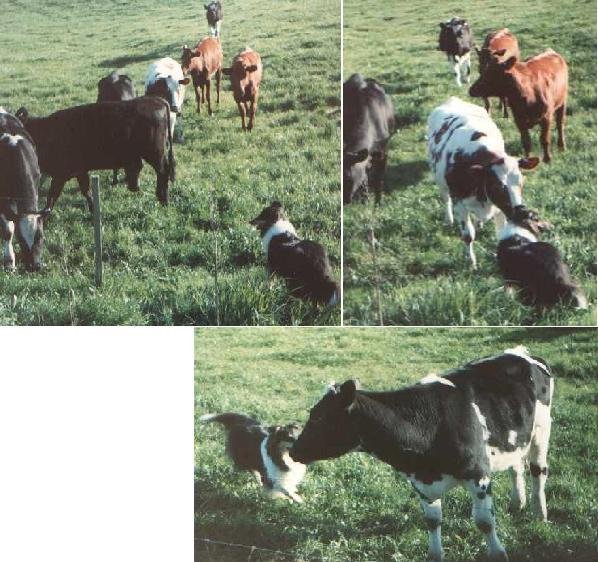All dogs shown are my own
A well trained herding Collie has an enormous working
capacity. There are several qualities that are required of
a good herding Collie such as soundness of body and mind,
agility, trainability, stamina and adaptability. A Collie which
is sly and a coward are useless in herding.
It must of course have herding instinct, take a
look at the pups parents, herding instinct are hereditary.
I think it’s easier to work with a Collie with great courage
and perhaps a little “callous”, then a softer dog.
Start early to let the Collie see
sheeps/cows. I have started when my Collies have
been 3 ½ to 4 months
Herding instinct is derived from the Collie's instinct
to hunt - the prey drive. His pack instinct gives him
the desire to work with you (the pack leader) while
doing so.
When we are herding, the Collie controls the stock, but
I control my Collie. Herding is teamwork between the
dog and the handler and the relationship between the
dog and the handler is very important, yet the Collie has
to use its own initiative and judgement
The work with sheep/hens/cows demands that the Collie is obedient.
Herding is a controlled activity, absolutely not a wild frenzy of activity, the dog is not allowed to chase.
It is important that they know and are responsive to certain commands before they are taken for a first training session on stock. They have to know, as a minimum, stay (stand, sit or lay down) and recall. They also have to know left from right, and here I use my arms. I train this moment with a help from a fence, my Collie is on one side and I am on the other. Also use voice and a flute is also helpful in the work
It’s important to read the dog
Don’t forget to praise the Collie when he is doing the right thing, that’s very important. Be consistent. Don’t train when you are in a bad mood, which would destroy your training and the relationship with your Collie. Build up a confidence with your Collie. Train short period of times, the training shall always be fun
Herding is a fascinating and extremely enjoyable challenge. Few activities offer the variety of situations and the opportunity for real teamwork between handler and a dog that are a part of herding. It must be able to work with gentleness, yet show strength in facing up to a stubborn animal. The background of the Collie is that of an adaptable, level-headed all-rounder. Collies are capable of being keen herders while remaining sensible, flexible family companions, whether as working dogs on a ranch or farm or helping out a suburban owner who keeps a few sheep, goats, or ducks as a hobby.
Participation in herding helps preserve the special heritage of the Collie and opens up new opportunities for owner and dog. The qualities that make a good herding dog -- trainability, adaptability, loyalty, soundness of body and character, agility, grace -- are important in many areas, and contribute so much toward making the dog an outstanding companion as well.
A little about herding
In order to begin training it is important to understand a few basic concepts, such as herding instinct and the beginning stages of training. You should also learn the vocabulary of herding.
It is important to understand the herding instinct. Herding stock is not based on the dog's "love" for the stock ( a common misconception).
Mari Taggert states
"the most commonly accepted theory is that a doglike animal first became man's friend . . . Then, gradually, the dog participated in the hunt and man saw that the dog's help made things easier . . . It was likely that the faster dogs would outrun the hunted animals, circling in front of them to slow them down or turn them back so that man could kill them.
We can stop right here as far as herding instinct is concerned, for this is what has formed the (albeit crude) basis for today's herding instinct."
Therefore, we must
remember that herding
instinct is derived from
the dog's instinct to hunt
- the prey drive. His pack
instinct gives him the
desire to work with you
(the pack leader) while
doing so. Livestock also
respond instincts when
they were prey and move
away from a dog that
approaches them. It is
important for us to
remember that once we
have awakened our Collie's
herding instinct we have
awakened an instinct that
is based on the prey drive.
It should not be surprising
then that your dog may
attempt to bite stock,
especially if you are reaching
for the animal - after all,
the instinct is based on the dog bringing the animal to the human to kill.
It is important to be prepared for this eventuality, but do not tolerate it. Training is important to overcome this instinctive behaviour. Taggert states "Shepherds throughout history have believed any dog, even the best sheepdogs, will kill livestock, given the right circumstances."
The Relationship
When herding, the dog controls the stock, but YOU control the dog. Herding is teamwork between the dog and the handler where the relationship between the dog and the handler is important. Taggert (p.30) states "No dog will give its best to a stranger, or even a family member that it doesn't consider its master. Dogs must be strongly attached to their trainer. They must love and respect the trainer - qualities that will deepen and be enhanced as training proceeds. Some breeds will only work for their "love object" and the rest of the world can take a hike. Get to know your dog and help him love and respect, not fear, you...You'll be expecting unusual obedience from your dog. There is no way you can MAKE a dog stop at one half mile away; he must want to do so to please you."
Training
Virgil Holland describes herding as "envisioning the handler as the 'coach' and the dog as the 'player'. You send in the signal and immediately the dog responds. At the same time, your dog must independently think how best to carry out the command, relying on natural ability . . . They must instantly react to a signal and then re-enter their instinctive world . . . "
This description is the goal we strive to achieve in our training: we give a command (the correct/appropriate one!); our Collie responds (appropriately!) to the command; the task is accomplished (correctly!) - all of this being done in a calm manner! However, it will take training to achieve.
Beginning to Train for Herding
Remember that herding is a controlled activity, absolutely not a wild frenzy of activity. Before taking your dog to stock, be sure that the dog has a reliable STOP and a reliable RECALL. When herding, the stop may be a stand, sit or down.
Generally young, keen dogs should be taught to "down" since they don't usually stop when standing. As training progresses and the dog becomes more reliable and comfortable with its role with stock, you can move to a stand for the stop. Many herders use the command "there" to indicate to the dog that he is to stop and stand.
Know how to read your dog. Knowing when to "push" your dog and knowing when to "ease off" contribute to successful training. This is no different in training for herding as it is in training for other activities.
So, as we move into fall and winter, our thoughts about herding need not be put on hold until spring. We can work on our STOP and RECALL. We can make these commands reliable at home, in the park, outside the mall....wherever; so that in the spring we can get into that pen with stock. Remember that you must also have a counter-command for the stop - a command which will release the dog from the stop. You will also learn commands to send your dog away from you after a recall; the command will depend on what will be done next.
Equipment
There is not a lot of equipment needed to train herding. A 5 foot bamboo pole or if this is not available, a piece of ½ inch PVC piping will do the trick. A flat buckle collar that will not slip over the dog's head is needed as well as a 15 - 20 foot woven training line. The long line should be used only by someone who knows how to handle it since long lines can become tangled and cause injury to dog, sheep or handler. Some trainers also train the dog to respond to a whistle. A common plastic whistle will do.
And of course you also need sheep and a field.
Glossary of Herding Terms and Commands
Balance: the correct positions of the dog, stock and handler relative to each other.
Dog-broke: stock that is accustomed to being worked with dogs.
Driving: moving stock from behind and away from the handler.
Fetch: bringing the stock to the handler from some distance away, preferably in a straight line.
Gathering: moving stock towards the handler from the opposite side of the stock.
Grip: a nip or bite when needed or on command; used to move stubborn stock.
Lift: moving the stock off the fence or the initial movement of the stock towards the handler.
Loose-eyed: a dog that works upright and does not keep eye contact with the stock at all times.
Strong-eyed: a dog that works by staring at the stock.
Outrun: when the dog is sent out some distance to the opposite side of the stock
to gather them to the handler. Usually the outrun is a semi-circular or pear shaped path.
Penning: moving the sheep into a pen or holding area.
Shedding: separating one (shedding) or more (splitting) stock from the rest.
Sides: the direction the dog is to go: clockwise or counter clockwise.
Wearing: the action of the dog moving side to side in a short arc to move the stock.
"Lie down": used as a stop command to drop the dog on a prone position. This may be replaced later in training by "there", "stand" "stand, stay" or "stay" to have the dog stop on his feet in a standing position.
"Stay": tells the dog not to move from its stopped position until a counter-command is given.
"Walk up": used to move the dog straight towards the stock. Other terms which may be used are: "Walk in" and "Go in".
"Easy": used to tell the dog to approach the stock or move around the stock more slowly. Other terms which are used for this: "steady", "take time" or "time".
"Come Bye": used to direct the dog to swing in a clockwise direction around the stock. The term "Go bye" is also used for this action. This clockwise movement is also referred to as being
"off the left hand" of the handler (Holland, p.23)
"Away To Me: used to direct the dog in a counter-clockwise direction around the stock. The term
"Way to Me" is also used. This counter-clockwise movement is also referred to as being "off the right hand" of the handler (Holland, p.23).
"Look Back": If the stock has split and the handler wants the dog to go farther from the handler to gather stock the dog may not see.
"Get Back": used to remind the dog to stay the proper distance away from the stock.
"Get Out": used if the dog is very close to the stock, splitting stock, diving to pull wool...
This command is considered a reprimand.
"That'll Do": This is the last command and can be considered as "Good job, old boy; now come here and we'll go to the house and get a treat for you". It should be an absolute call off.
WHAT IS SHEEPDOG TRIALLING
Those who need to look after sheep, sometimes on difficult country, need the help of one or more able sheepdogs. For many years dogs have been bred to develop the traits of intelligence, stamina and obedience. How do we know which breed lines are producing the most able dogs?
By arranging competitions, or demonstrations, where the abilities can be compared - these are sheepdog trials.
The culmination of the breeder's skill is demonstrated in sheepdog trials, and although breeding is of paramount importance, it is the Sheepdog trial that is the 'shop window' for the end result of the breeder's labours, and is the endless delight of those who compete and those who spectate.
Many trials take place at a local level, often with friends involved.
As far as possible, the conditions and work to be encountered in everyday shepherding on the hills and farms Sheepdog trials. They are not intended as a succession of 'tricks' or gimmicky obstacles, but rather a practical demonstration of the skills the dog uses every day of his working life. The dogs you see on the Trials field are not kept specially for the trial by their owners - those same dogs will have been at work, probably that very morning before setting off for the Trial, but it is true to say that the skills they acquire in their everyday work are essential to help them gain maximum points. The system of scoring at Trials is that a maximum number of points are allocated for each element and dog and handler actually'lose' points for any faults as they progress around the course.
Here is a sketch showing how the trial is in Norway (and getting approved herdingtest)

